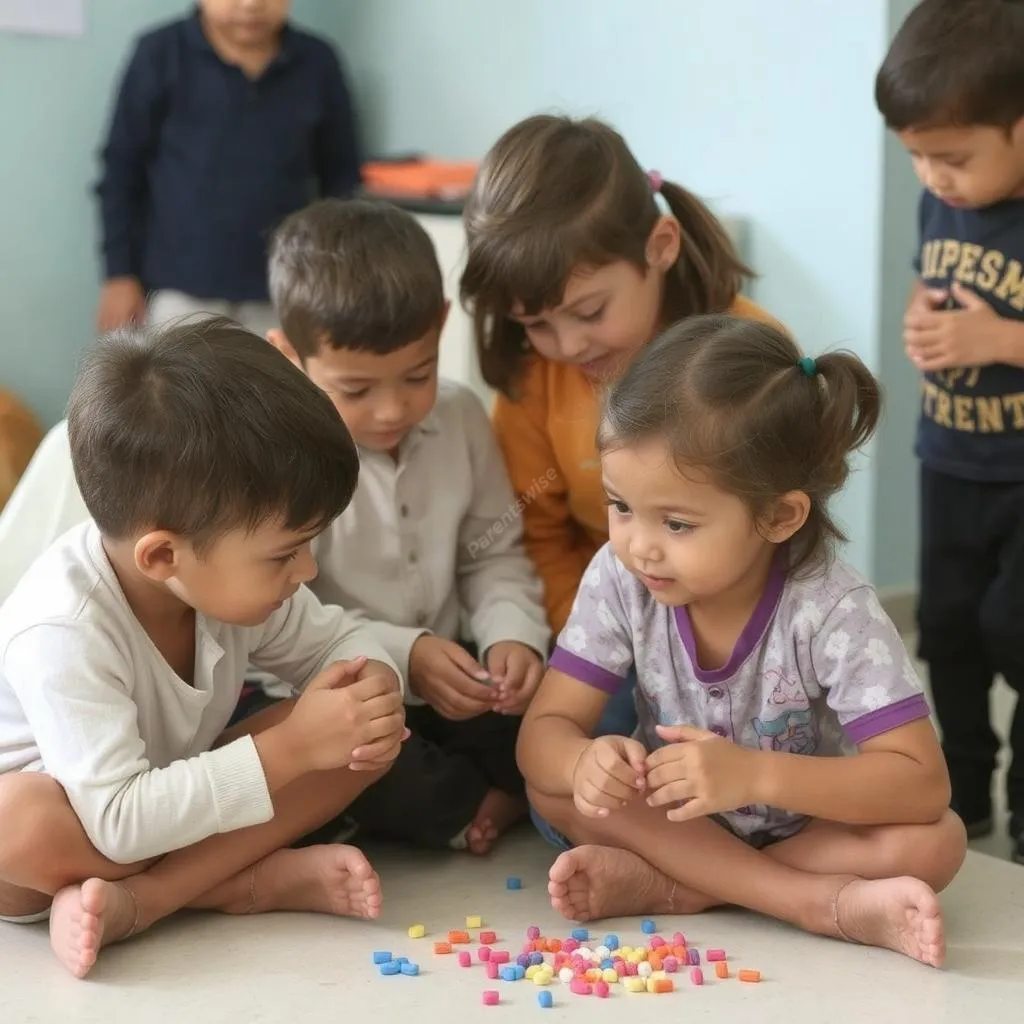The Power of Empathy in Successful Step-Parenting

Introduction
Blended Families: A Modern Reality
Did you know that nearly 40% of American families are blended? These families include step-parents, step-siblings, or half-siblings. It’s a common situation, but it comes with its own set of challenges.
The Challenge of Step-Parenting
Step-parenting can test even the most patient and loving parents. It’s not always easy to blend two families. But there’s hope! Research shows that one powerful tool can make a big difference.
Empathy: The Key to Success
That tool is empathy. It’s the ability to understand and share others’ feelings. Empathy can transform your step-parenting journey from stressful to successful.
What You’ll Learn
In this article, we’ll explore:
- How empathetic step-parenting strengthens family bonds
- Practical communication skills for blended families
- Tips to navigate your role as a step-parent
We’ll show you how to use empathy to create a harmonious blended family. Let’s get started on your path to successful step-parenting!
Understanding Empathy in Step-Parenting

What is Empathy?
Empathy is the ability to understand and share the feelings of another person. It’s like putting yourself in someone else’s shoes. In step-parenting, this means trying to see things from your stepchild’s point of view.
Why Empathy Matters in Blended Families
Empathy is crucial in blended families because:
- It helps build trust between step-parents and stepchildren
- It creates a safe emotional space for everyone to express themselves
- It aids in resolving conflicts more effectively
- It promotes family bonding and unity
Sympathy vs. Empathy: What’s the Difference?
Many people confuse sympathy with empathy. Here’s a quick comparison:
| Sympathy | Empathy |
|---|---|
| Feeling sorry for someone | Understanding someone’s feelings |
| Offering comfort from a distance | Sharing the emotional experience |
| “I feel bad for you” | “I understand how you feel” |
| Can create emotional distance | Builds emotional connection |
Understanding this difference can help you approach step-parenting with genuine empathy, leading to stronger relationships within your blended family.
The Benefits of Empathetic Step-Parenting

Better Family Communication
Empathy opens doors to meaningful conversations. When step-parents show they truly understand, family members are more likely to share their thoughts and feelings. This leads to:
- Fewer misunderstandings
- More open and honest discussions
- A stronger sense of family unity
Building Trust and Stronger Bonds
Trust is the foundation of any good relationship. Empathetic step-parenting helps:
- Create a safe emotional environment for stepchildren
- Show stepchildren that their feelings matter
- Develop deeper connections between family members
Over time, this trust grows into strong, lasting bonds.
Reducing Family Tension
Empathy acts as a natural conflict resolver. When everyone feels understood, there’s less room for anger and resentment. This leads to:
- Fewer arguments
- Quicker resolution of disagreements
- A more peaceful home environment
Creating a Supportive Family Atmosphere
An empathetic approach fosters a nurturing family climate. Here’s how:
- It encourages family members to support each other
- It promotes understanding of different perspectives
- It creates a “we’re in this together” mindset
- It helps everyone feel valued and respected
Remember, a supportive family environment doesn’t happen overnight. It takes consistent effort and patience from all family members, especially step-parents.
Developing Empathy as a Step-Parent

Self-Reflection: The First Step
Becoming more empathetic starts with looking inward. Ask yourself:
- How do I react to challenging situations?
- What are my own biases or preconceptions?
- How do my actions affect others in the family?
This self-awareness helps you understand your own emotions better, making it easier to relate to others.
Active Listening: The Key to Understanding
Active listening is a crucial skill for empathetic step-parents. Here’s how to do it:
- Give your full attention when family members speak
- Avoid interrupting or planning your response while they talk
- Use non-verbal cues (like nodding) to show you’re listening
- Reflect back what you’ve heard to ensure understanding
Remember, the goal is to truly hear and understand, not just to respond.
Perspective-Taking: Walking in Their Shoes
Try to see situations from your stepchild’s or partner’s point of view. Ask yourself:
- How might they be feeling right now?
- What past experiences might be influencing their reaction?
- If I were in their position, how would I feel?
This exercise helps you develop a more rounded view of family dynamics.
Patience and Understanding: The Long Game
Building empathy takes time. Be patient with yourself and your family members. Some tips:
- Don’t expect perfection from yourself or others
- Celebrate small improvements in family relationships
- Remember that setbacks are normal and part of the process
- Keep practicing empathy, even when it’s challenging
Developing empathy is an ongoing journey. With consistent effort, you’ll see positive changes in your blended family relationships.
Empathy Towards Your Stepchildren
Understanding Their Unique Challenges
Stepchildren often face complex emotions and situations. They might:
- Feel torn between biological parents
- Struggle with loyalty conflicts
- Experience grief over family changes
- Face adjustment issues in their new family setup
Recognizing these challenges helps you respond with more compassion.
Respecting Their Feelings About the New Family
It’s normal for stepchildren to have mixed feelings about their new family. To show empathy:
- Validate their emotions, even if you don’t agree
- Avoid pressuring them to “get over it” quickly
- Give them space when they need it
- Be patient as they adjust to changes
Remember, acceptance takes time and can’t be forced.
Supporting Their Relationship with Biological Parents
Encourage your stepchildren to maintain strong bonds with both biological parents:
- Never speak negatively about their other parent
- Facilitate communication with the other parent when possible
- Respect their time with their other parent
- Support their participation in important events with both families
This approach shows that you care about their overall well-being.
Allowing Space for Adjustment
Every child adjusts at their own pace. Here’s a general timeline to keep in mind:
| Time Frame | What to Expect |
|---|---|
| 0-6 months | Initial adjustment, possible resistance |
| 6-12 months | Gradual acceptance of new family structure |
| 1-2 years | Developing new family traditions and bonds |
| 2+ years | Deeper integration and comfort in blended family |
Remember, this timeline is just a guide. Some children may adjust faster, while others might take longer. The key is to remain patient and empathetic throughout the process.
Empathy Towards Your Partner

Understanding Their Role as a Biological Parent
Your partner faces unique challenges as both a biological parent and part of a blended family. They may:
- Feel torn between their children and you
- Struggle with guilt about the family changes
- Face pressure to balance everyone’s needs
Recognizing these challenges helps you support your partner better.
Supporting Their Parenting Decisions
Showing empathy towards your partner’s parenting choices is crucial:
- Avoid criticizing their parenting style in front of the children
- Discuss concerns privately and calmly
- Offer support, even if you might do things differently
- Remember that consistency is key for children
This approach helps maintain a united front in the family.
Navigating Co-Parenting Challenges Together
Co-parenting with an ex-spouse can be tricky. Here’s how to be empathetic:
- Listen to your partner’s frustrations without judgment
- Offer emotional support during difficult times
- Help brainstorm solutions to co-parenting issues
- Respect boundaries between your family and the ex-spouse
Your empathy can make a big difference in easing co-parenting stress.
Balancing Couple Time and Family Time
It’s essential to nurture your relationship while managing family responsibilities:
- Schedule regular date nights
- Create daily rituals for just the two of you (like a morning coffee)
- Plan occasional getaways without the children
- Communicate openly about your needs as a couple
Remember, a strong partnership forms the foundation of a healthy blended family.
Empathy Towards Yourself

Acknowledging Step-Parenting Challenges
Being a step-parent is tough. It’s important to:
- Recognize that you’re doing a difficult job
- Understand that mistakes are normal and part of learning
- Accept that not everything will go smoothly all the time
- Celebrate your efforts and small victories
Remember, self-compassion is key to maintaining empathy for others.
Setting Realistic Expectations
Avoid putting too much pressure on yourself:
- Don’t expect instant love or acceptance from stepchildren
- Understand that building relationships takes time
- Accept that there will be good days and bad days
- Know that it’s okay to not have all the answers
Realistic expectations help you stay positive and patient.
Self-Care Strategies for Step-Parents
Taking care of yourself is crucial. Try these self-care tips:
- Make time for hobbies or activities you enjoy
- Practice mindfulness or meditation to reduce stress
- Exercise regularly to boost mood and energy
- Connect with friends for emotional support
- Treat yourself to small indulgences occasionally
Remember, you can’t pour from an empty cup. Self-care helps you be a better step-parent.
Seeking Support When Needed
It’s okay to ask for help. Consider:
- Joining a step-parent support group
- Talking to a therapist or counselor
- Confiding in trusted friends or family members
- Reading books or blogs about step-parenting
Seeking support shows strength, not weakness. It helps you gain new perspectives and coping strategies.
Overcoming Empathy Challenges in Step-Parenting

Dealing with Resistance from Stepchildren
It’s common for stepchildren to resist new family dynamics. Here’s how to handle it:
- Stay patient and keep showing empathy
- Don’t take their resistance personally
- Give them space when needed
- Keep communication lines open
Remember, persistent kindness often breaks down walls over time.
Managing Conflicting Loyalties
Stepchildren might feel torn between biological parents and step-parents. To help:
- Reassure them it’s okay to love both parents
- Never speak badly about their other parent
- Encourage their relationship with both biological parents
- Avoid putting them in the middle of adult conflicts
This approach helps reduce emotional stress for the children.
Addressing Past Hurts and Resentments
Old wounds can hinder empathy. To move forward:
- Acknowledge past pain without dwelling on it
- Focus on building a positive future together
- Consider family therapy if issues persist
- Practice forgiveness – for others and yourself
Healing takes time, but it’s crucial for family harmony.
Strategies for Maintaining Empathy During Conflicts
Conflicts are inevitable. Here’s how to stay empathetic:
- Take deep breaths to stay calm
- Listen more than you speak
- Try to understand the other person’s perspective
- Use “I” statements to express your feelings
- Take a break if emotions run too high
- Focus on finding solutions, not placing blame
These strategies help keep empathy alive even in tough moments.
Teaching Empathy to Children in Blended Families

Modeling Empathetic Behavior
Children learn best by example. To model empathy:
- Show understanding towards family members’ feelings
- Demonstrate active listening when others speak
- Express your own emotions in a healthy way
- Apologize sincerely when you make mistakes
Remember, your actions speak louder than words.
Encouraging Open Communication
Create an environment where everyone feels safe to express themselves:
- Have regular family meetings
- Ask open-ended questions to encourage sharing
- Validate feelings, even if you disagree with actions
- Teach children to use “I feel” statements
Open communication builds trust and understanding.
Family Activities to Promote Empathy
Here are some activities to try:
| Activity | Description | Benefit |
|---|---|---|
| Role-playing | Act out scenarios from different perspectives | Helps children understand others’ viewpoints |
| Emotion charades | Guess emotions based on facial expressions and body language | Improves emotional recognition skills |
| Gratitude journaling | Write down things you’re grateful for about each family member | Fosters appreciation and positive feelings |
| Volunteer together | Help at a local charity or community event | Develops compassion for others |
These activities make learning empathy fun and interactive.
Books and Resources on Empathy for Different Age Groups
Reading can be a powerful tool for teaching empathy:
- For young children (4-8): “The Invisible Boy” by Trudy Ludwig
- For tweens (9-12): “Wonder” by R.J. Palacio
- For teens (13+): “The Hate U Give” by Angie Thomas
- For parents: “The Whole-Brain Child” by Daniel J. Siegel and Tina Payne Bryson
Discuss these books as a family to reinforce empathy lessons.
Conclusion

The Power of Empathy in Step-Parenting
Empathy is truly the secret ingredient for successful step-parenting. Let’s recap why it’s so important:
- It improves communication within the family
- It helps build trust and stronger relationships
- It reduces conflict and tension
- It creates a supportive family environment
Putting Empathy into Practice
Remember, becoming an empathetic step-parent is a journey:
- Start with self-reflection and awareness
- Practice active listening and perspective-taking
- Be patient with yourself and your family members
- Keep working on it, even when it’s challenging
Creating a Harmonious Blended Family
With empathy as your guide, you can:
- Foster understanding between all family members
- Create a loving, supportive home environment
- Help your stepchildren feel valued and heard
- Strengthen your relationship with your partner
Every small step towards empathy is a step towards a happier, more harmonious blended family.
Additional Resources
Online Support Groups for Step-Parents
Professional Counseling Options
- Family therapists specializing in blended families
- Online counseling platforms like BetterHelp or Talkspace
- Local support groups for step-parents
Remember, seeking help is a sign of strength, not weakness. Don’t hesitate to reach out if you need support on your step-parenting journey.
This concludes our comprehensive guide on “The Power of Empathy in Successful Step-Parenting.” We hope these insights and strategies help you nurture a loving, empathetic blended family. Your efforts matter, and with patience and understanding, you can create a harmonious home for all.
